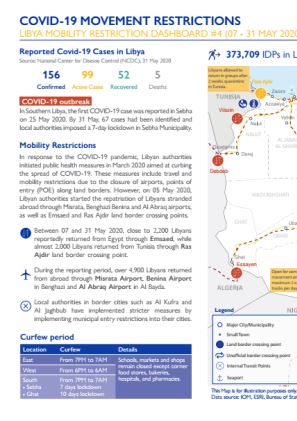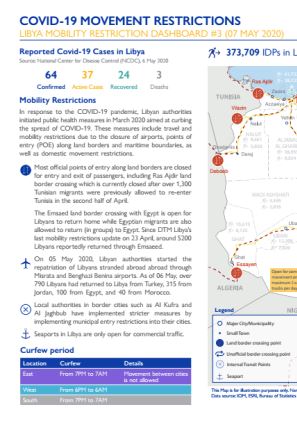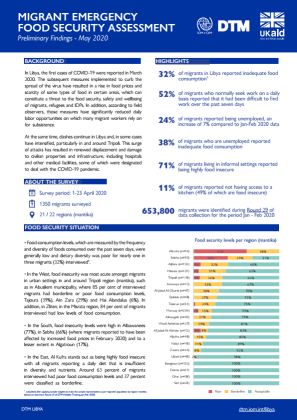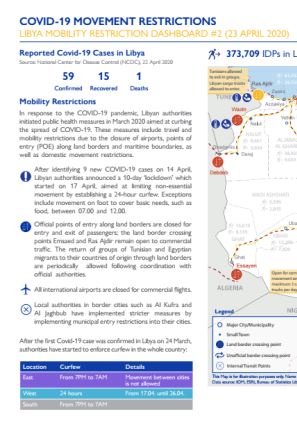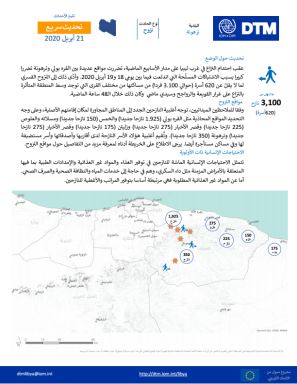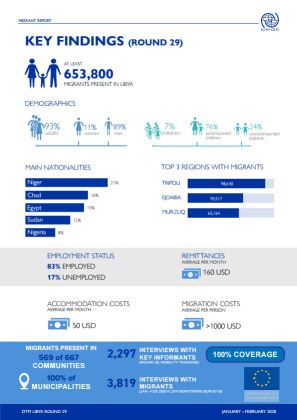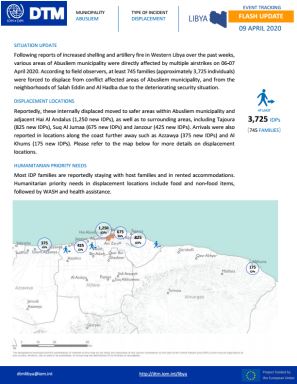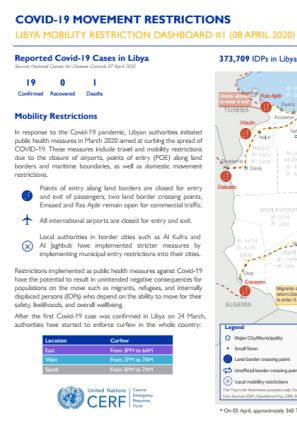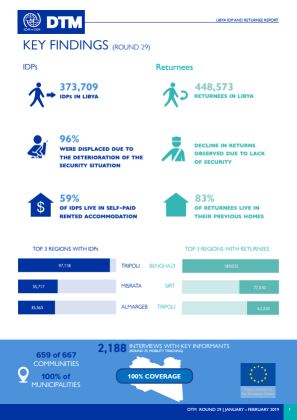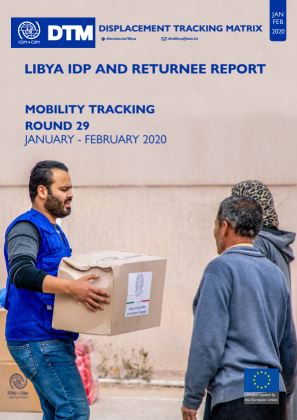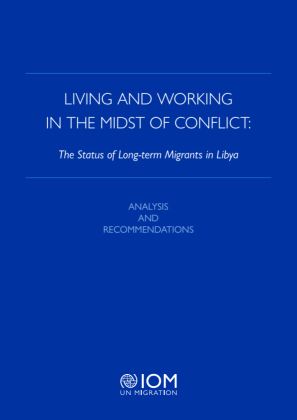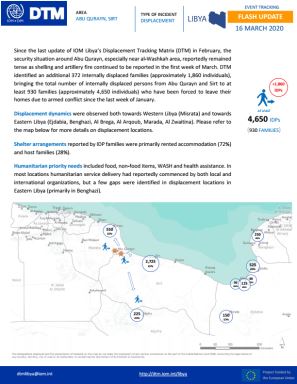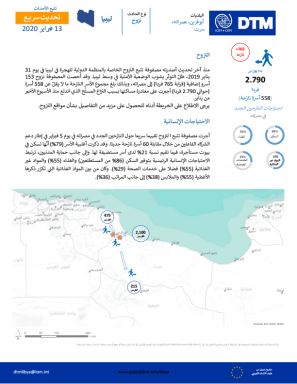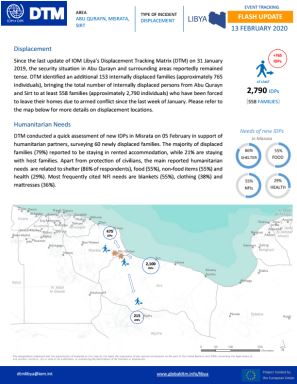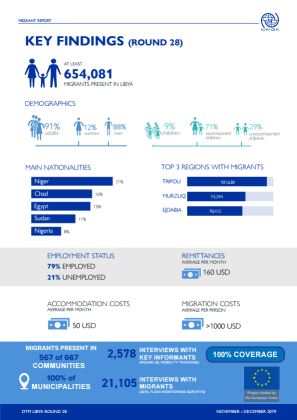-
Countries
-
Data and Analysis
-
Special Focus
-
Crisis Responses
Libya
About Libya
Libya is a geographically vast country with several regions that are difficult to access. In order to understand the full scope of humanitarian assistance that is needed throughout the country, IOM established the Displacement Tracking Matrix (DTM) programme in 2016 in order to provide a common operating picture concerning the movement of populations in Libya, allowing humanitarian actors to provide timely assistance to those in need. Following the escalation of conflict and insecurity in 2014, the security situation has remained volatile since with fluctuations in the intensity of localized clashes. Congruently, conflict has caused new displacements, often in areas ill-equipped to accommodate large population movements while also negatively impacting the large migrant population residing and transiting through Libya. More recently, the capital Tripoli was heavily affected by displacement waves in September 2018 and April 2019.
DTM’s mobility tracking and flow monitoring activities identified many migrants in-country to be in need of various forms of assistance. Libya’s geographic location, resources and work opportunities has made it both a country of destination and transit for migrants for many years. Despite the deterioration of the security situation since 2011 migrants continue coming to and transiting through Libya, the majority from Sub-Saharan and North African countries.
In this complex operating environment, DTM Libya has been providing a common operating picture concerning the movement of populations in Libya since 2016, allowing humanitarian actors to provide timely assistance to those in need. Through its mobility tracking, flow monitoring and needs assessment activities, DTM Libya has established itself as data hub for quantitative data on migratory flows to and within Libya, migrant presence in Libya disaggregated by nationality and area, as well as humanitarian needs of migrants, internally displaced population and returnees. All activities are implemented through periodical bi-monthly data collection cycles, allowing trend analysis over time to provide evidence-base for both policy-level discussions and to guide humanitarian action.
In order to facilitate humanitarian interventions, DTM works closely with IOM’s other programmes through referring identified populations in need of assistance at flow monitoring points to IOM’s Direct Assistance, Health, Voluntary Humanitarian Return (VHR), Protection and Migrant Rapid Response Mechanism (MRRM) programmes. Furthermore, DTM Libya supports other humanitarian partners through providing emergency tracking updates in case of sudden population movements as well as facilitating humanitarian assessments for the Rapid Response Mechanism (RRM) jointly implemented by IOM, UNICEF, WFP and UNFPA.
For more information on IOM's activities in Libya, please visit the IOM Libya country office website.
Contact
DTM Libya
DTMLibya@iom.int
Current Donors
- EUTF
Libya — Mobility Restriction Dashboard 4 (07 - 31 May 2020)
In response to the COVID-19 pandemic, Libyan authorities initiated public health measures in March 2020 aimed at curbing the spread of COVID-19. These measures include travel and mobility restrictions due to the closure of airports, points of entry (POE) along land borders.
Libya — Migrant Emergency Food Security Report (May 2020)
This report presents findings of IOM Libya’s Displacement Tracking Matrix (DTM) migrant food security assessment conducted by IOM field staff between 01 - 23 April 2020 in 37 municipalities (baladiya) across 21 regions (mantika) amongst a total of 1350 migrants.
Libya — COVID-19 MOBILITY TRACKING 1 (16 May 2020)
DTM initiated a bi-weekly assessment component as part of its mobility tracking activities aimed at understanding the impact of Covid-19 related mobility restrictions and curfews on vulnerable mobile populations in Libya.
Libya — Mobility Restriction Dashboard 3 (7 May 2020)
In response to the COVID-19 pandemic, Libyan authorities initiated public health measures in March 2020 aimed at curbing the spread of COVID-19.
Libya — Detention Centre Profile Generator (April 2020)
Detention Centre Profiling is a component of IOM Libya’s Displacement Matrix programme. It is a data oriented tool that routinely provides specific sex and age demographic data and key sectorial information on individuals held in Libya’s detention Centres on the date of assessment.
Libya — Migrant Emergency Food Security Assessment (Preliminary Findings - May 2020)
In Libya, the first cases of COVID-19 were reported in March 2020.
Libya — Mobility Restriction Dashboard 2 (23 April 2020)
In response to the COVID-19 pandemic, Libyan authorities initiated public health measures in March 2020 aimed at curbing the spread of COVID-19.
Libya — Tarhuna Flash Update (21 April 2020) [ARABIC]
Following intensification of the conflict in Western Libya over the past weeks, several locations between Garabolli and Tarhuna were heavily affected by armed clashes on 18-19 April 2020.
Libya — Tarhuna Flash Update (21 April 2020)
Following intensification of the conflict in Western Libya over the past weeks, several locations between Garabolli and Tarhuna were heavily affected by armed clashes on 18-19 April 2020.
Apr 21 2020
Libya — Tarhuna Flash Update (21 April 2020)
Migrant Report Key Findings Round 29 (Jan-Feb 2020)
Migrant Report Key Findings Round 29 (Jan-Feb 2020)
Libya — Migrant Report 29 (Jan-Feb 2020)
This report presents the findings of DTM Round 29 (January - February 2020) data collection, in which at least 653,800 migrants from over 40 countries of origin were identified in Libya.
Apr 21 2020
Libya — Migrant Report 29 (Jan-Feb 2020)
Libya — Abusliem Flash Update 1 (09 April 2020)
Following reports of increased shelling and artillery fire in Western Libya over the past weeks, various areas of Abusliem municipality were directly affected by multiple airstrikes on 06-07 April 2020.
Apr 09 2020
Libya — Abusliem Flash Update 1 (09 April 2020)
Libya — Mobility Restriction Dashboard 1 (08 April 2020)
In response to the Covid-19 pandemic, Libyan authorities initiated public health measures in March 2020 aimed at curbing the spread of COVID-19.
Libya — IDP & Returnee Report, Round 29 (Jan-Feb 2020) [ARABIC]
يستعرض هذا التقرير نتائج الجولة التاسعة والعشرين المستخلصة من عمل وحدة تتبّع التنقل الخاصّة بمصفوفة تتبع النزوح في ليبيا والتي تغطّي الفترة الممتدة بين شهري يناير وفبراير من سنة 2020 . وخلال الجولة 29 ، ارتفع عدد النازحين داخليا في ليبيا من 355.672 نازحا إلى 373.709 نازحا.
Apr 05 2020
Libya — IDP & Returnee Report, Round 29 (Jan-F…
Libya — IDP and Returnee Key Findings Report 29 (Jan-Feb 2020)
This report presents the Key findings of Round 29 of the mobility tracking component of the Displacement Tracking Matrix (DTM) programme in Libya.
Libya — IDP & Returnee Report, Round 29 (Jan-Feb 2020)
This report presents the findings of Round 29 of the mobility tracking component of the Displacement Tracking Matrix (DTM) programme in Libya, covering the reporting period from January to February 2020.
Apr 05 2020
Libya — IDP & Returnee Report, Round 29 (Jan-F…
Libya — Detention Centre Profile Generator (March 2020)
Detention Centre Profiling is a component of IOM Libya’s Displacement Matrix programme.
Libya — Living and Working in the Midst of Conflict: The Status of Long-term Migrants in Libya
To assess the circumstances of long-term migrants in conflict-affected Libya, IOM Libya’s Research Team, Displacement Tracking Matrix (DTM) programme and the Columbia University School of International and Public Affairs (SIPA) conducted this study in 2019 with
Libya — Abu Qurayn, Sirt, Misrata Flash update 3 (16 March 2020)
Since the last update of IOM Libya’s Displacement Tracking Matrix (DTM) in February, the security situation around Abu Qurayn, especially near al-Washkah area, reportedly remained tense as shelling and artillery fire continued to be reported in the first week of March.
Libya — Detention Centre Profile Generator (February 2020)
Detention Centre Profiling is a component of IOM Libya’s Displacement Matrix programme. It is a data oriented tool that routinely provides specific sex and age demographic data and key sectorial information on individuals held in Libya’s detention Centres on the date of assessment.
Libya — Abu Qurayn, Sirt, Misrata Flash Update 2 (13 Feb 2020) [Arabic]
منذ آخر تحديث أصدرته مصفوفة تتبع النزوح الخاصة بالمنظمة الدولية للهجرة في ليبيا في يوم 31 يناير 2019، ظلّ التوتّر يشوب الوضعية الأمنية في وسط ليبيا.
Libya — Abu Qurayn, Sirt, Misrata Flash update 2 (13 Feb 2020)
Since the last update of IOM Libya’s Displacement Tracking Matrix (DTM) on 31 January 2019, the security situation in Abu Qurayn and surrounding areas reportedly remained tense.
Migrant Report Key Findings Round 28 (Oct-Dec 2019)
This report presents the findings of DTM Round 28 (October - December 2019) data collection, in which at least 654,081 migrants from 40 countries of origin were identified in Libya.
Libya — Migrant Report 28 (Oct-Dec 2019)
This report presents the findings of DTM Round 28 (October - December 2019) data collection, in which at least 654,081 migrants from 40 countries of origin were identified in Libya.
Feb 12 2020
Libya — Migrant Report 28 (Oct-Dec 2019)
Pagination
Pagination
- First page
- Previous page
- 1
- 2
- 3
- 4
- 5


